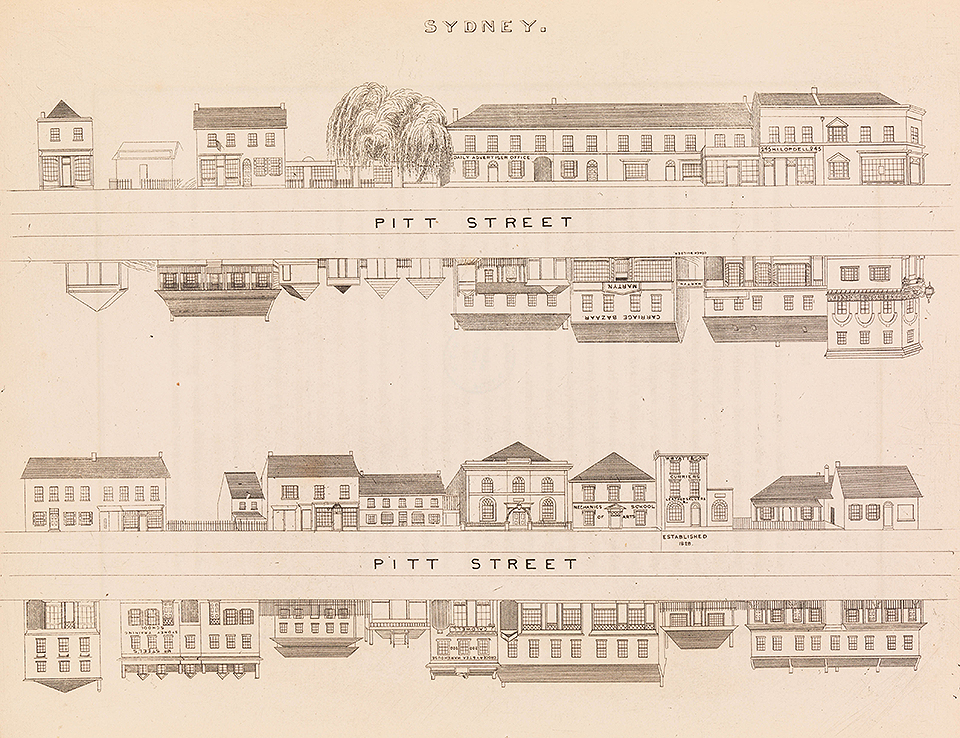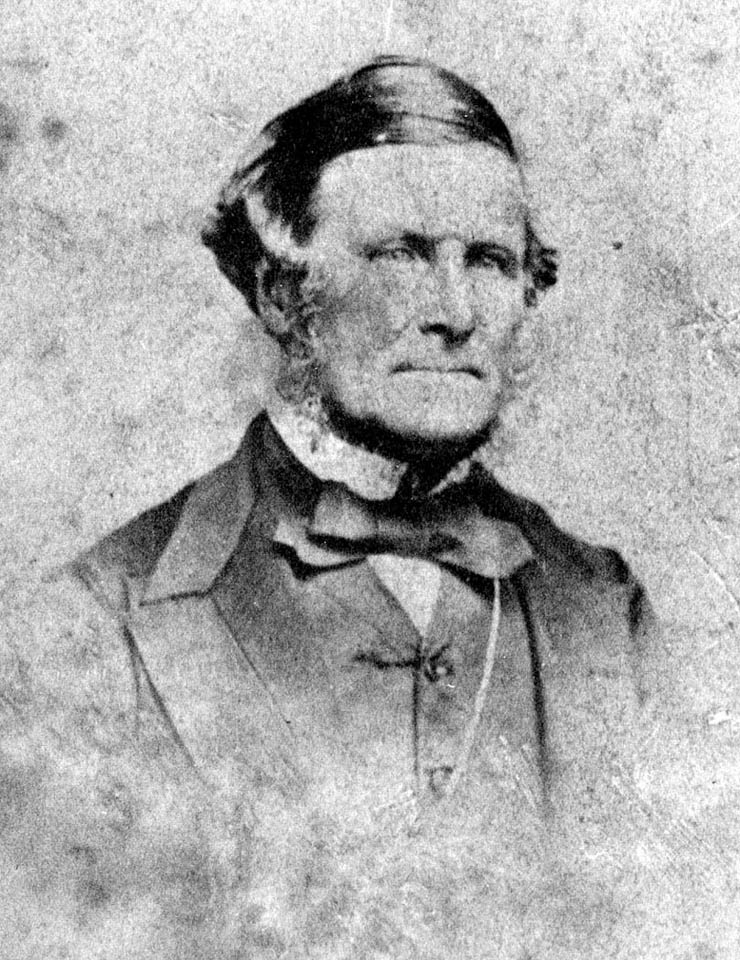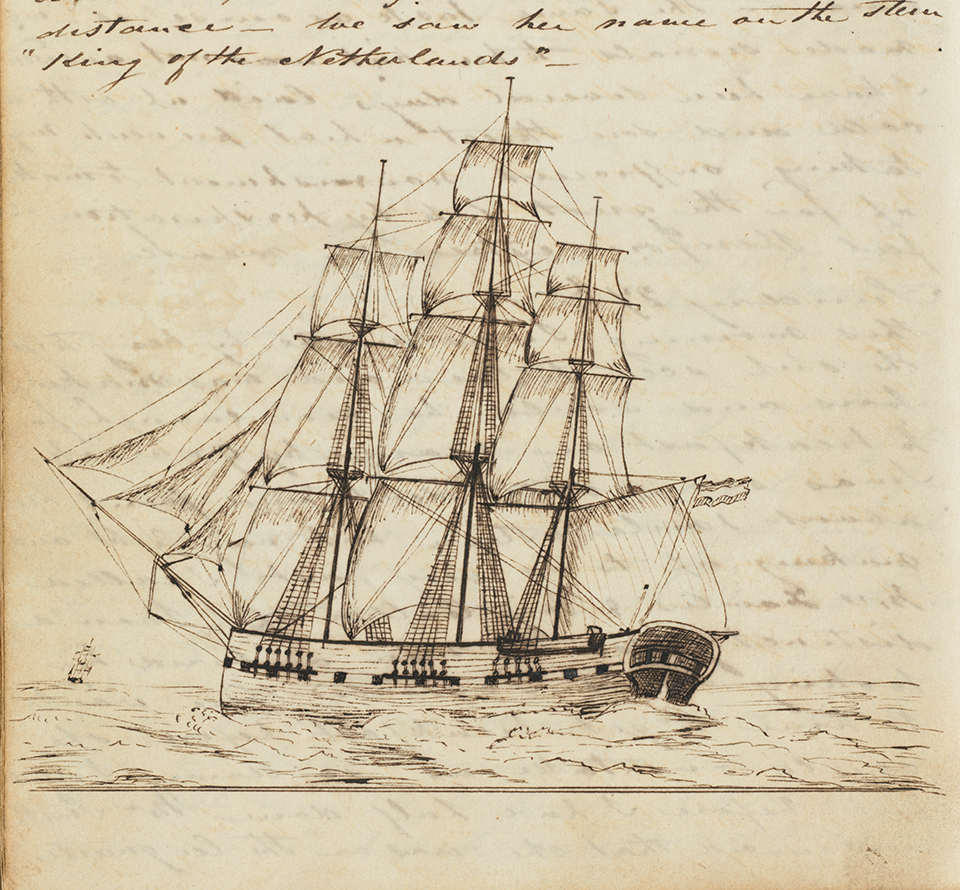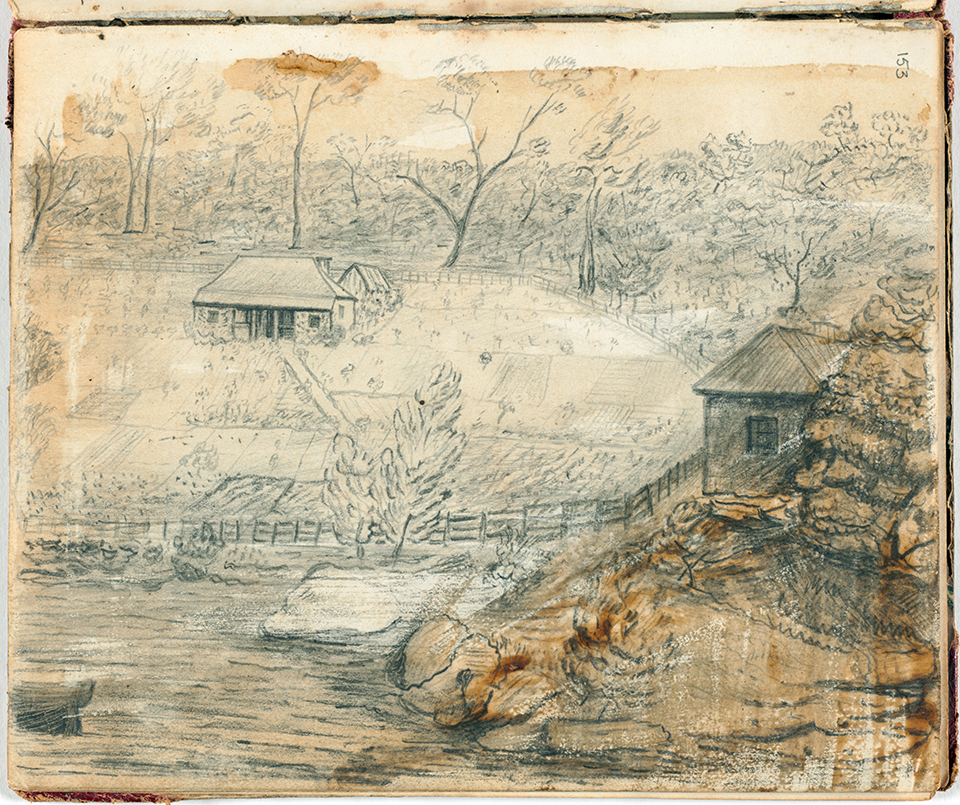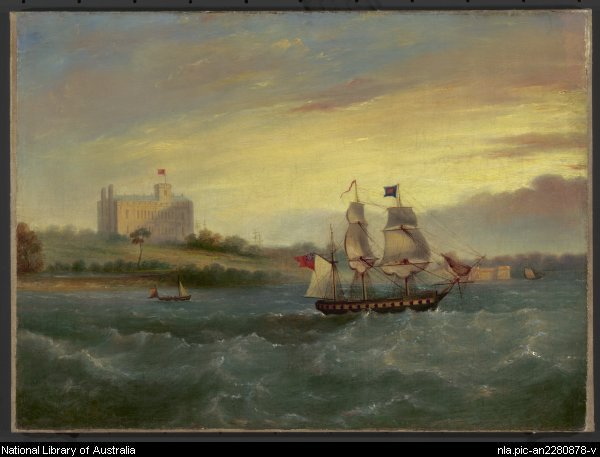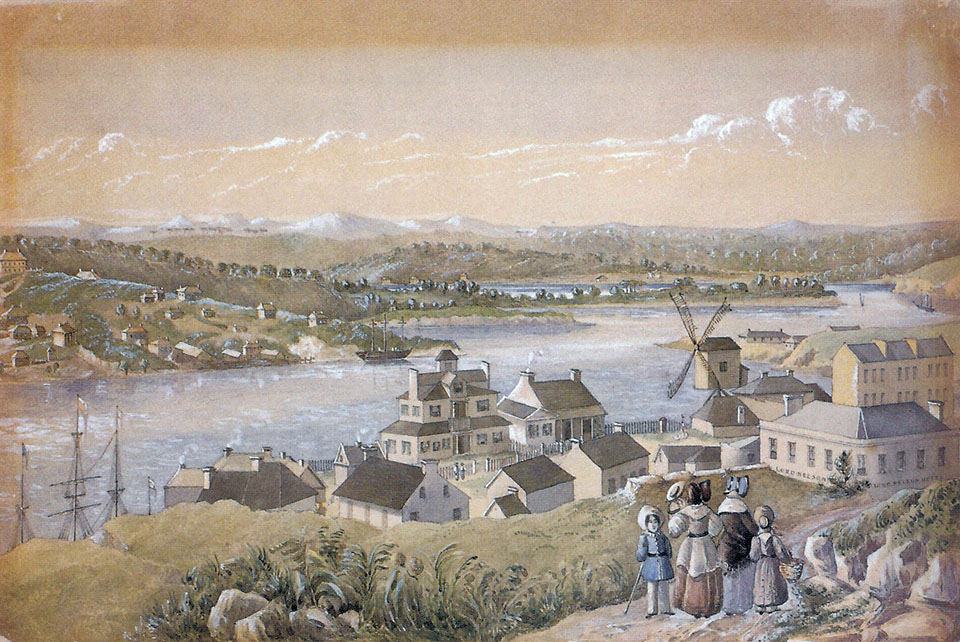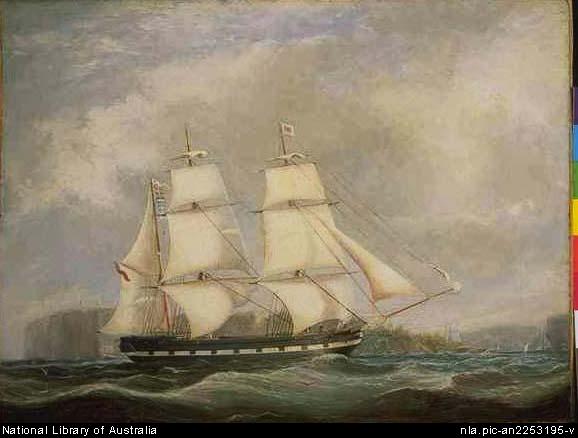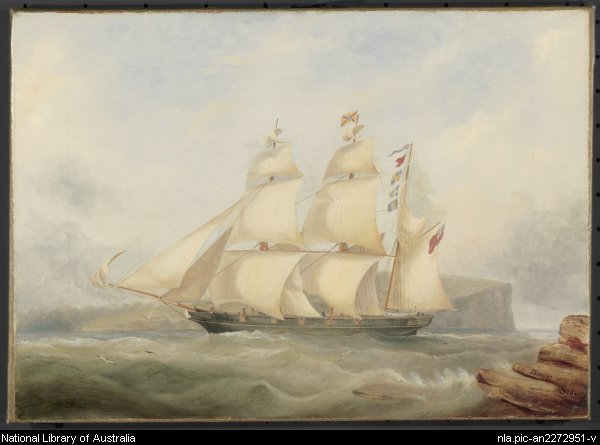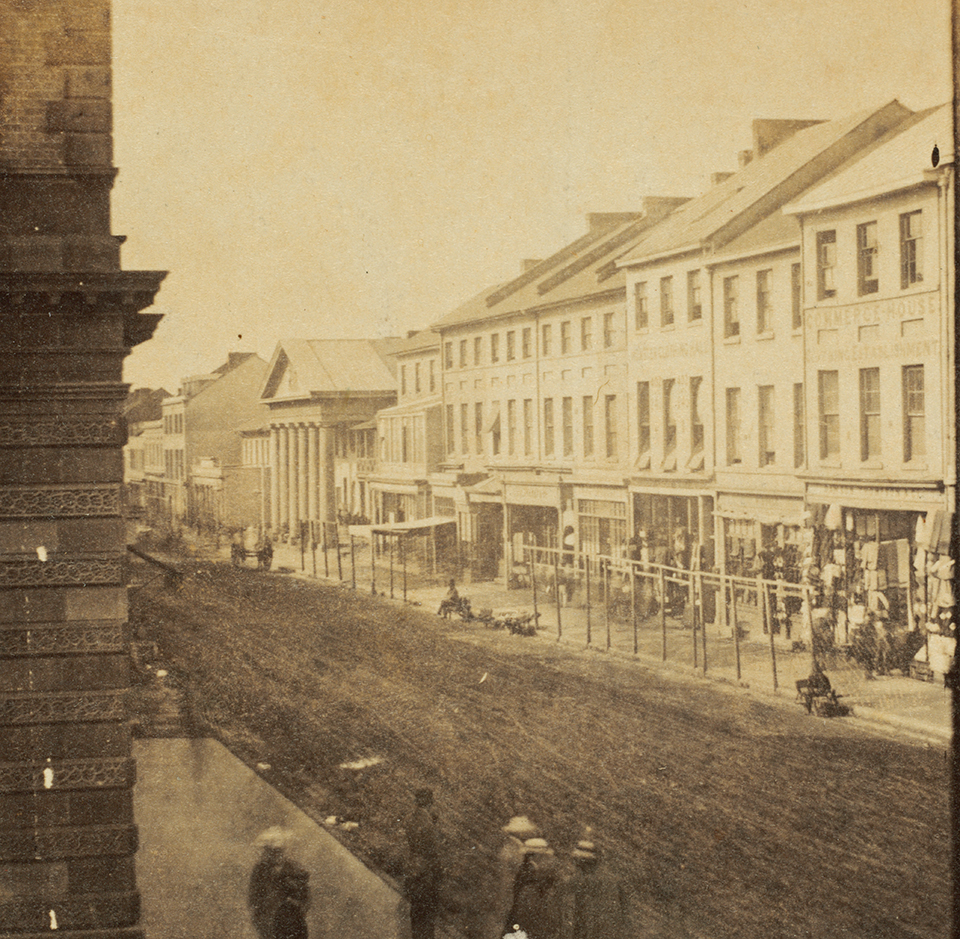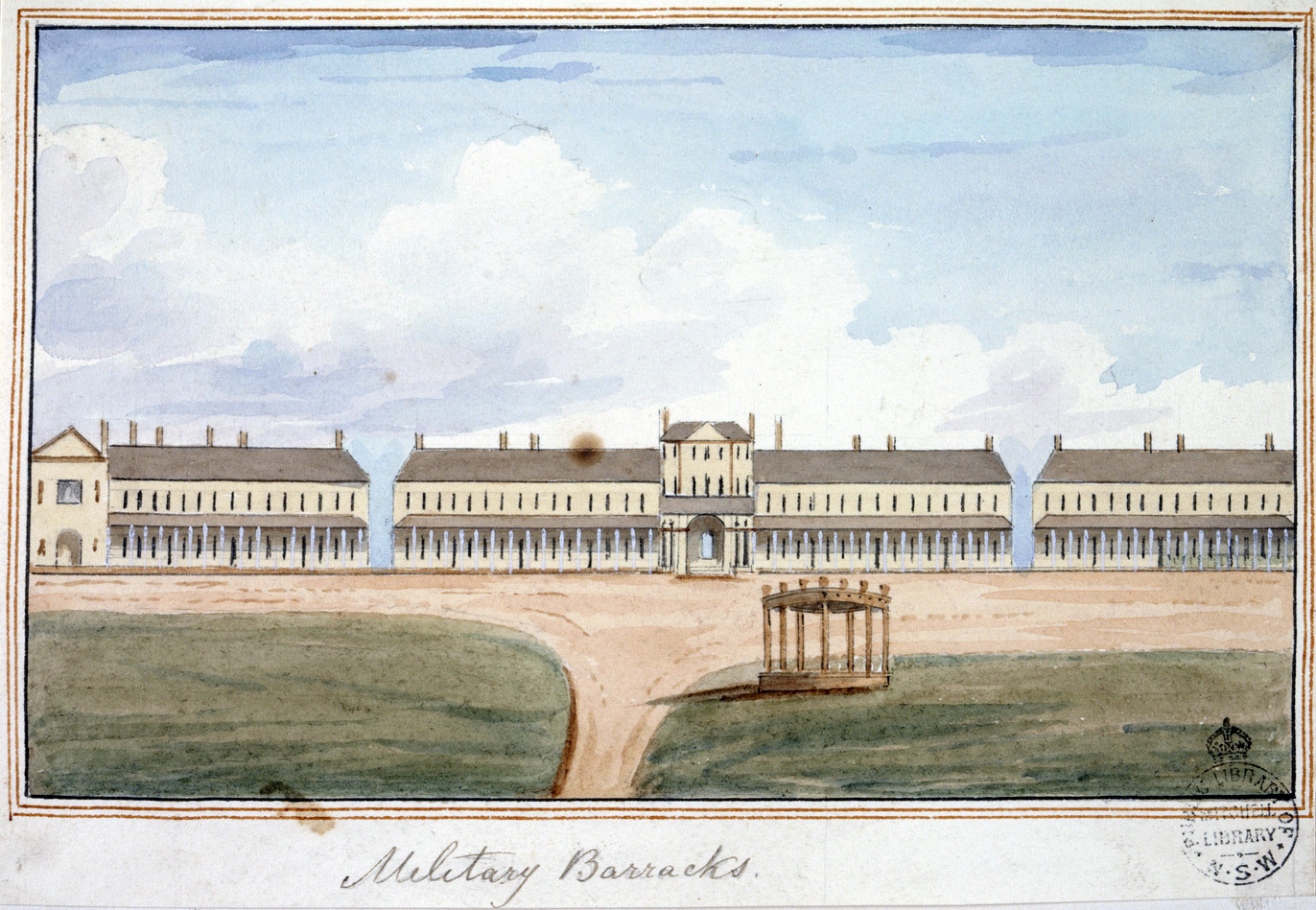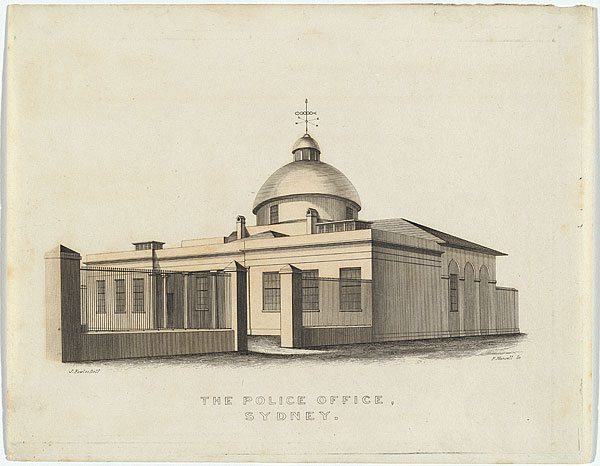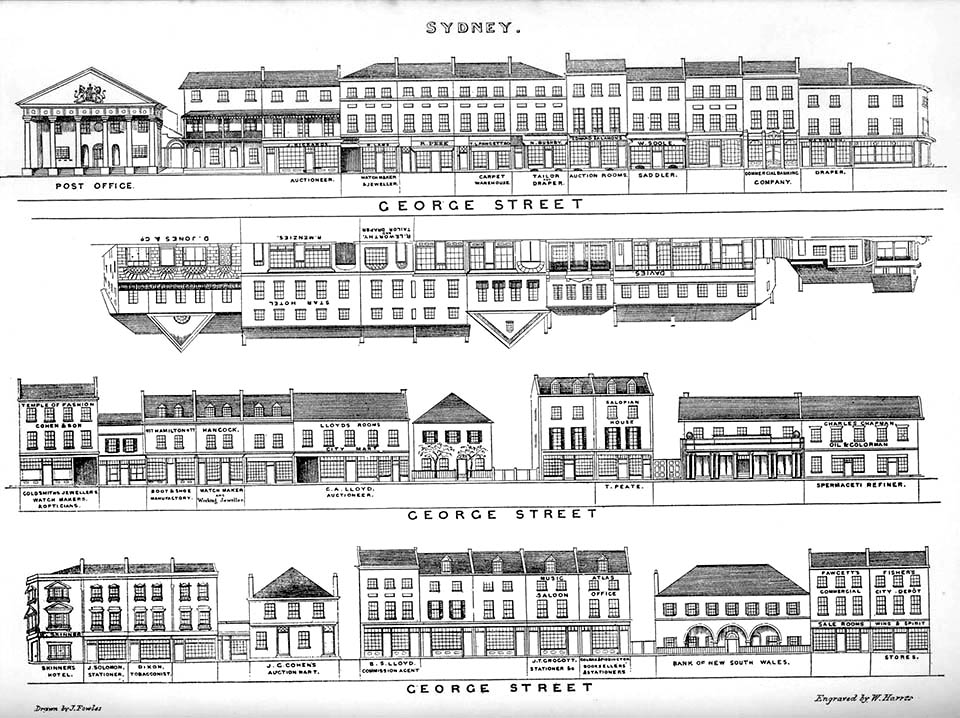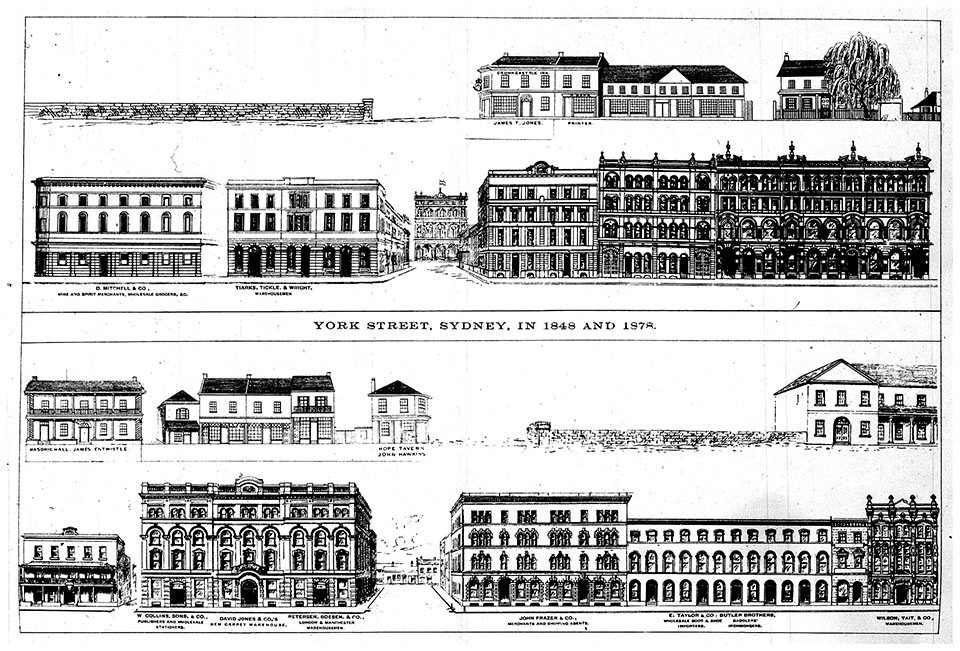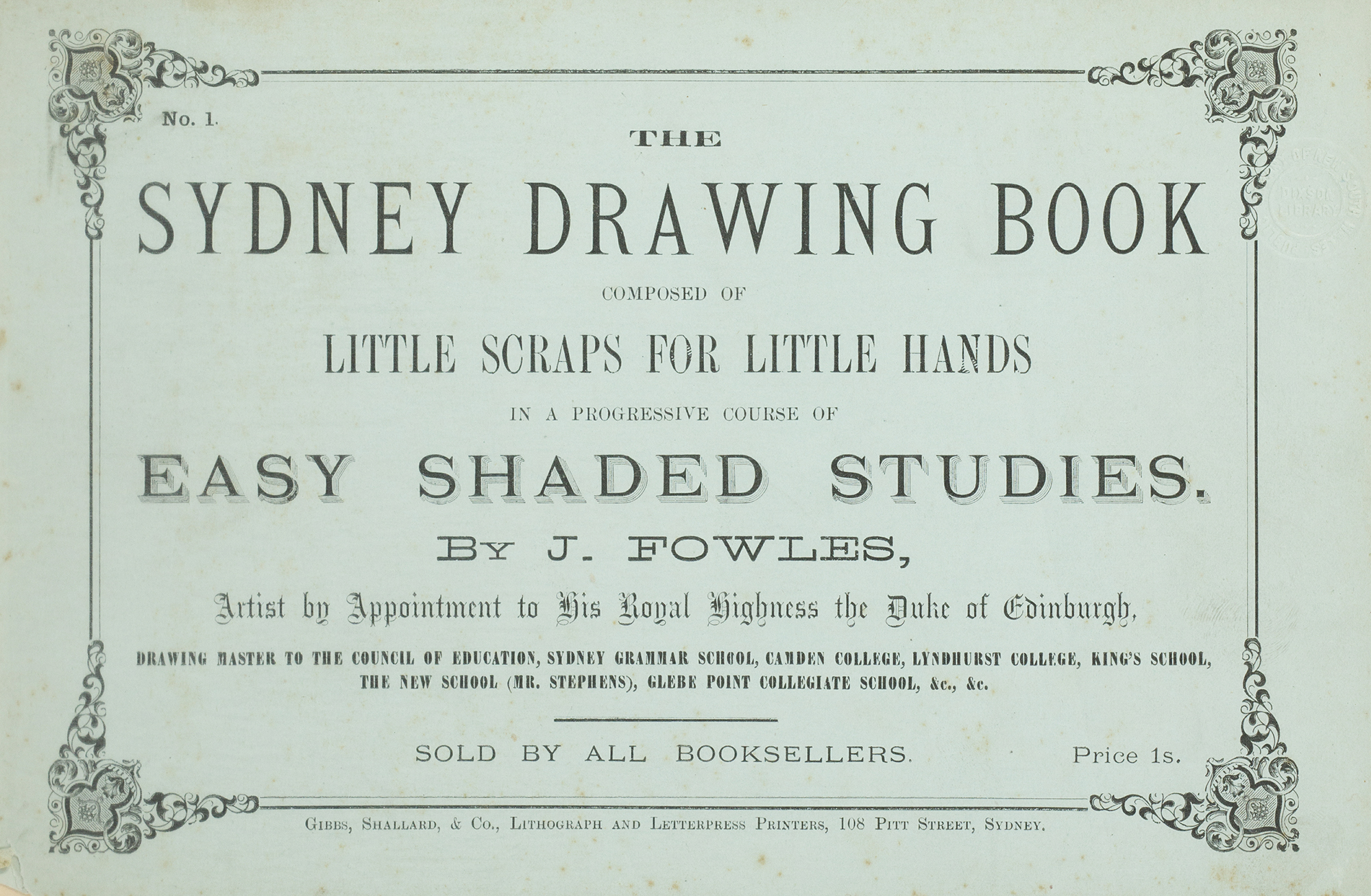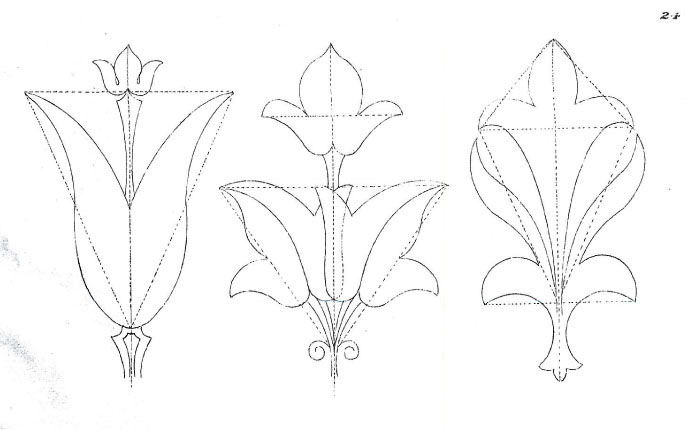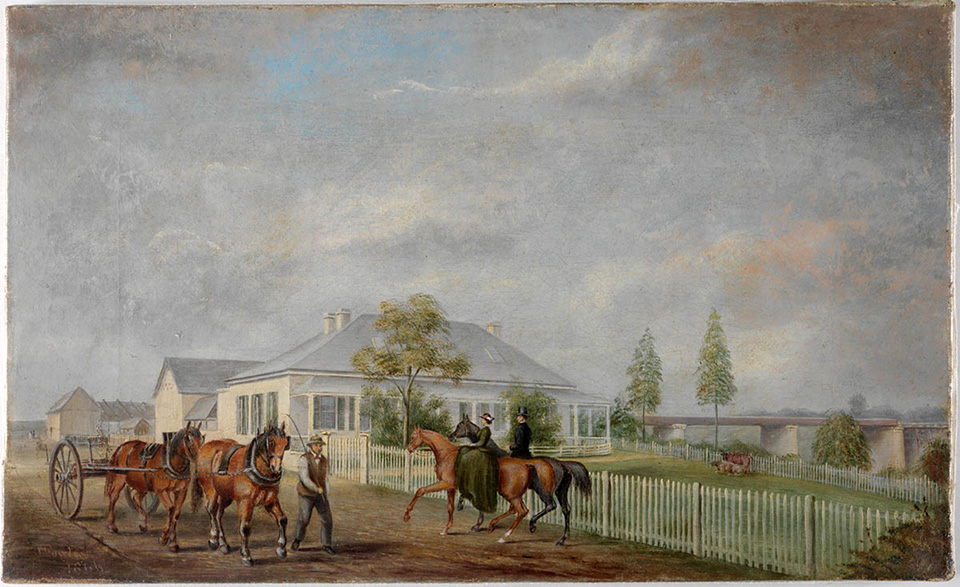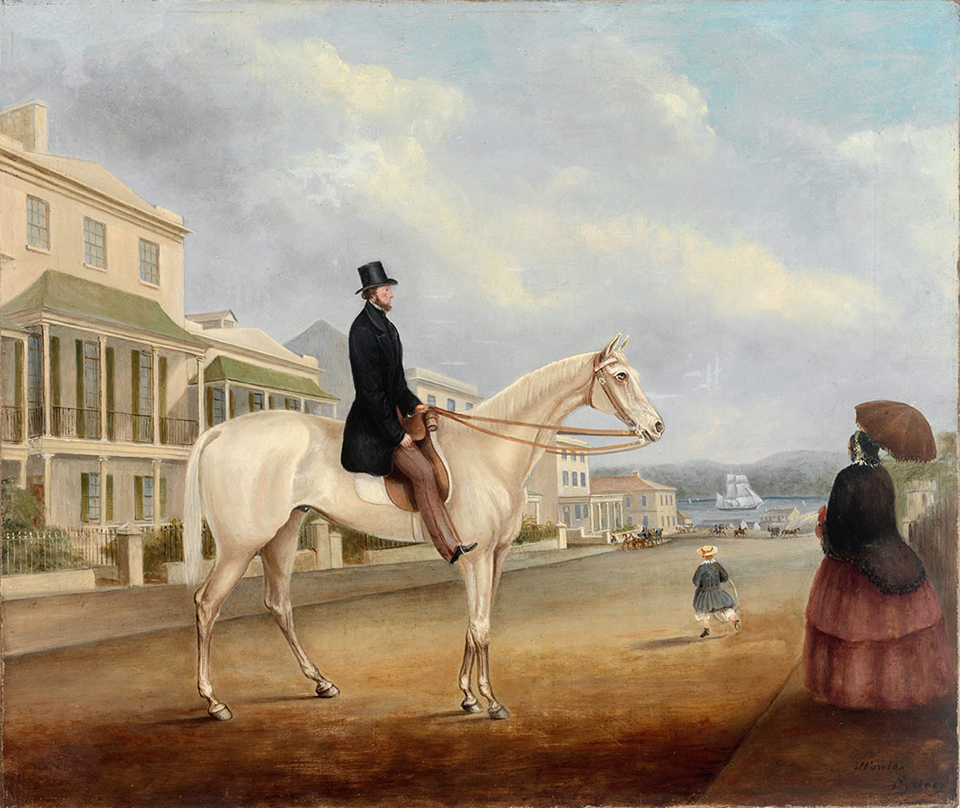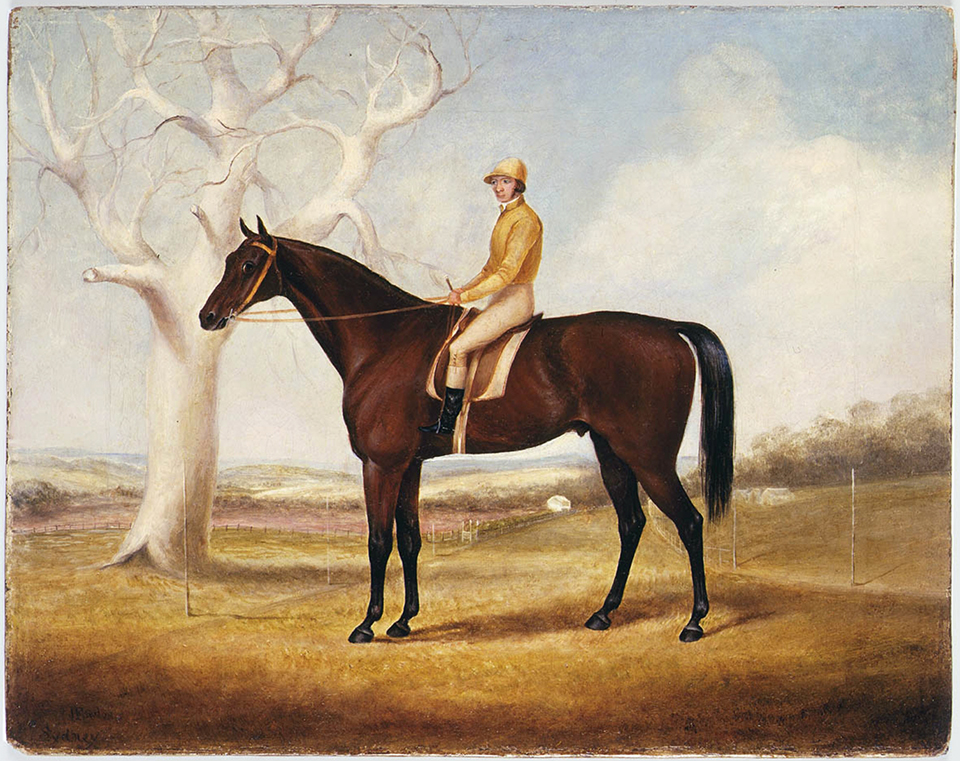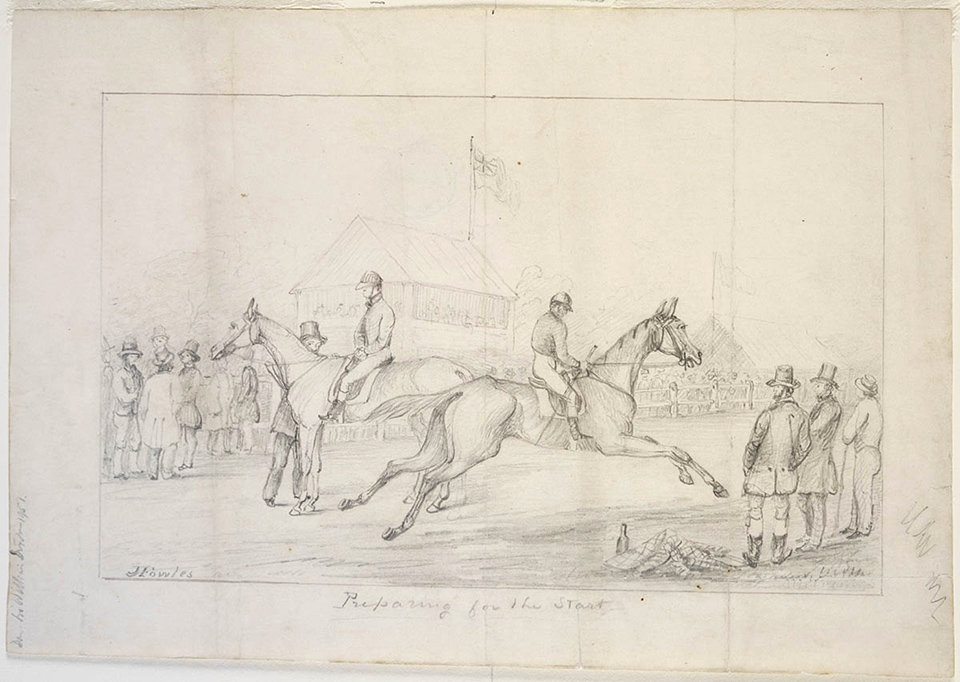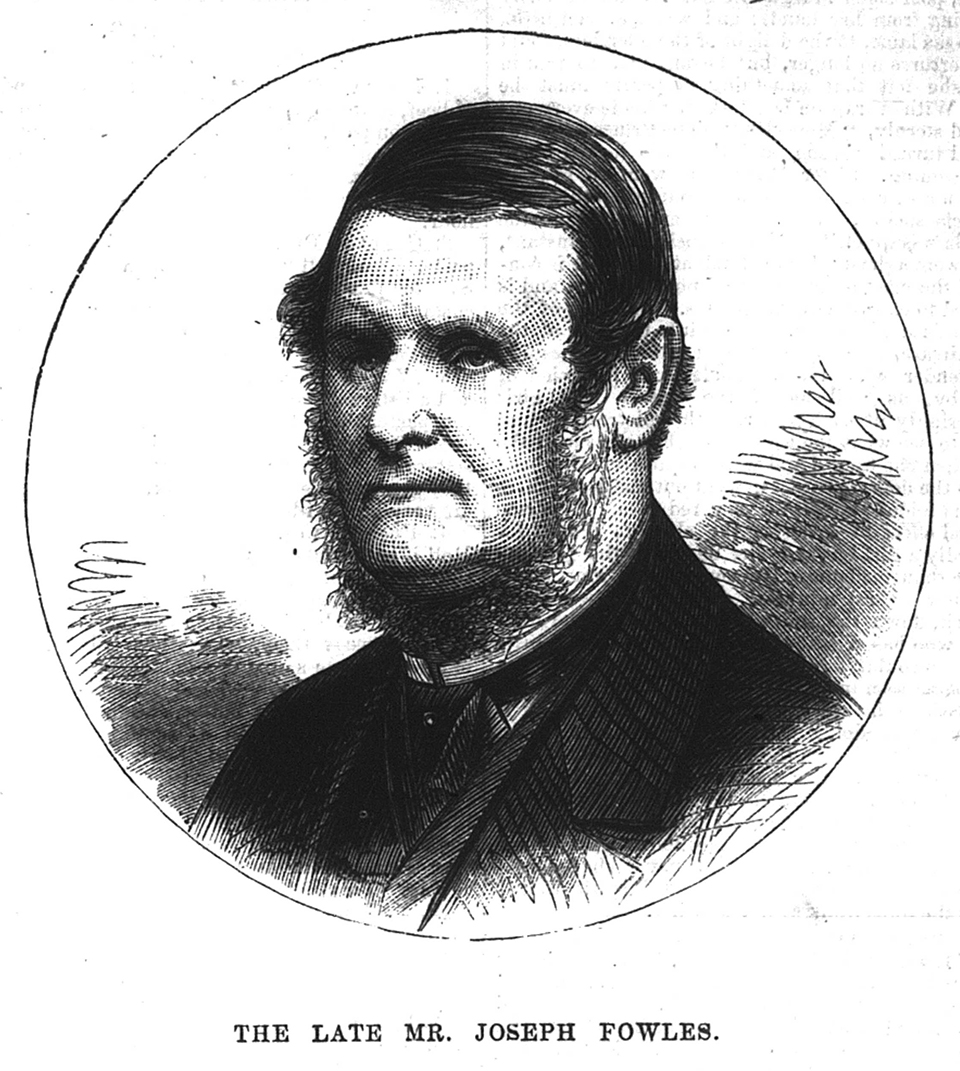The Dictionary of Sydney was archived in 2021.
Fowles, Joseph
Citation
Persistent URL for this entry
To cite this entry in text
To cite this entry in a Wikipedia footnote citation
To cite this entry as a Wikipedia External link
Fowles, Joseph
[media]The artist Joseph Fowles is best remembered for his publication Sydney in 1848, which depicted Sydney's streets and buildings in that year. The book's purpose, according to Fowles, was to show Sydney as it really was, rather than the way it was perceived in England. The book's accurate drawings and accompanying descriptions have made it a valuable resource for studying nineteenth-century Sydney. While this is a lasting achievement of Fowles's years in Sydney, in his lifetime he was better known as an artist, racing enthusiast and drawing teacher.
Arrival in Sydney
Joseph Fowles [media]arrived in Sydney on board the barque Fortune on the morning of 31 August 1838. With him were his wife Sarah and a friend or companion from Gloucestershire, Miss Emily Lambrigg Collyer.[1] Fowles was an artist (although what training he had has not been established) and illustrated his journal during the voyage. His sketches hinted at his future career in Sydney as a marine artist, urban sketcher and drawing master, with views of islands passed, fish caught, towns visited and ships met on the way.
[media]The voyage took five months and gave Fowles time to indulge some of his passions as noted throughout his journal. He played the flute to amuse himself; he painted on the deck; and early in the voyage he took the wheel and steered the ship from the Downs (off the east coast of Kent) until in sight of Dover. Fowles also appears to have had some medical training, as he attended the cook, bleeding him and prescribing medicines for him, so he was once again 'able to attend to his duties'. [2]
The arrival in Sydney after five months at sea was a highly anticipated moment for Fowles. On the last morning of the voyage he wrote:
A man was ordered up to the fore top gallant mast head to look out for the light on Sydney heads – as it can be seen 30 miles in calm weather. I was upon deck nearly all night looking out very anxiously for the light and at about 2 in the morning it was first seen…the morning was dark & the light shone very brilliant - I continued looking at it till day light by which we were in near land opposite Botany Bay. [3]
His first impressions of Sydney are of a town nestled on a grand harbour which 'at a distance looks quite enchanting'. Fowles's experiences of arriving in Sydney are recorded in detail and hint at the common experience of many free emigrant settlers arriving in the first half of the nineteenth century. The ship was guided in by the pilot who joined her off of the heads, and was given three cheers by the sailors of another vessel already anchored as the Fortune slips into the Quay; friends and family of the passengers clambered aboard to welcome the new arrivals. Yet Fowles himself was struck by the enormity of the situation, and wrote:
I felt myself (in the midst of all this bustle) an apprehension which you will wonder at, nearly every one seemed in good I may say excellent spirits, but I felt the weight of my responsibilities in providing an honest living – and the difficulties that always surround a new settler from his ignorance. I also felt that I was about to leave the ship where I had been so comfortable and go and encounter hardships and privations perhaps to I had never before dreamt of… [4]
One of Fowles's first responsibilities was to find a home for himself and his family. Through a fortuitous meeting with a friend from London, whom he spotted from the deck of the Fortune, Fowles was able to inspect a small farm six miles (9.6 kilometres) from Sydney, at present-day Hunters Hill. Enchanted as he was, the steep and rocky nature of some of the land stayed his hand. However, after inspecting a mill on the Williams River in the Hunter Valley, Fowles returned to lease the Hunters Hill property (owned by Mary Reibey) known as Figtree Farm. Fowles noted in his journal that the farm was 110 acres (44.5 hectares), with a rough house and two unfinished workers' cottages. [media]He sketched his house, showing it among the cultivated ground surrounded by bush, with a small verandah and detached kitchen to the rear; six acres (2.4 hectares) were in cultivation facing the north-east, with the site sloping down to the water's edge. The river here was tidal and Fowles noted plenty of sea fish and the rocks covered in oysters.
The river was also the main route to Sydney:
This water is also very useful affording me a cheap conveyance for whatever we have to send and as there is no road without crossing the water we always go to Sydney in a boat. [5]
Fowles noted that this boat was a regular clipper, 15 feet long with a five and a half foot beam (4.5 metres long with a 1.6 metre beam); it had won a prize at the regatta in Sydney. Fowles worked his farm, supplying fruit and vegetables to the Sydney market for three years. As noted in his journal, his farm produced strawberries, grapes, peas, apples, plums, apricots, peaches, quinces, lemons and oranges, as well as a good supply of timber which he cut and sold in Sydney. [6]
Early years in Sydney
Fowles [media]and his family lived at the Hunters Hill farm until the mid-1840s. By this time, Fowles had already begun painting in Sydney – Ship in Sydney Harbour showing Government House, attributed to him in 1840, is one of his earliest known works.
[media]Other than his artistic work, Fowles's early years in Sydney are relatively obscure.
In July 1840 it appears that his wife Sarah returned to England and in 1841, Fowles and Emily Lambrigg Collyer, who had arrived in Sydney with the couple in 1838, had their first child. [7] While they never formally married, when she died twenty years later she was described as "the beloved wife of Joseph Fowles". They had seven children together.[8]
He may have been in business as a wine merchant in the early 1840s with a Robert Beames, although this partnership was dissolved in August 1843. [9] What other work he was involved in is not clear, but the wine business may have sustained him for a few more years after that.
In the same year, a darker episode of Fowles's Sydney life appeared in the local papers. In September 1843, Fowles and three colleagues were sailing in his yacht Breeze, heading down the harbour to watch a sailing race. As they returned up the harbour in the late afternoon, the wind picked up and the boat made towards shelter, reducing her sail as she went. Off Taylors Bay, near Bradleys Head, as the crew sought to bring in her sails, the yacht was struck by a westerly squall and capsized, sinking immediately. The four occupants were thrown into the harbour and by the time the nearest boat arrived, one of Fowles's companions, John Batten, was unconscious in the water, and a second, Mr Curtis of the Union Bank, had sunk beneath the waves. Although Batten was retrieved from the water, he could not be revived and died before they could get him to shore. Fowles and a second man, Mr Goddard, both managed to swim to nearby yachts and drag themselves aboard. At an inquest that followed, the two deaths were deemed accidental and no blame was attributed. [10]
The emerging artist
[media]By 1847 Fowles was gaining a profile as a marine painter and had opened a studio in Harrington Street on the edge of The Rocks. In July of that year, eight of his works were exhibited as part of the first public exhibition of paintings in New South Wales, presented by the Society for the Promotion of Fine Arts in Australia. All but one of the eight were of ships or maritime scenes, the odd one out titled Kangaroos. One of the maritime scenes was titled Shipping at the Mouth of the Thames, possibly one Fowles had brought with him from London. Fowles was described as a marine painter who succeeding in capturing the likeness of ships in his work, which it was noted had improved considerably since the reviewers had first known him. He could still improve though, with his drawing and colouring both needing work. The review noted that 'we think, Mr Fowles sometimes attempts too much for a young artist'. [11]
[media]In 1849 Fowles again entered the Society for the Promotion of Fine Arts Exhibition, with three more maritime scenes and a landscape. The first maritime painting, The Harpooner, Whaler, in a Squall, was described as having troubles, in that the sky was black and airless and the water green and motionless – similar criticisms to those levelled at his 1847 attempts. The second maritime painting, Dutch Galliott, was noted as being a meritorious marine painting, very superior to anything from the same hand in the exhibition, while the third, the Brig Peri scudding, was a faithful portrait, excellent in tone and of a style the society encouraged Mr Fowles to continue to pursue. [12] His landscape though was 'a glaring and unmeaning mixture of red, yellow and brown', but his style was enough to win him prizes during the same period, with two wins in the Sydney art union in 1848 and another in Joseph Grocott's third art union in July 1850. His Action at Sea won £10. [13]
Sydney in 1848
[media]While Fowles was establishing himself as a marine painter, he was also working on a much more ambitious project: a pictorial depiction of the town of Sydney in 1848.
When Fowles arrived in 1838, Sydney was a bustling town but still undeveloped in some ways. The Tank Stream, once the lifeblood of the town, was an open sewer; the Circular Quay was still a plan; Pitt, Castlereagh and Phillip streets did not run through to the harbour; and the military barracks and Sydney gaol were still in the centre of town in George Street. There was commerce and an embryonic mercantile and business district, but overall the town had developed slowly since the 1820s.
[media]The decade after Fowles arrived saw a transformation of the town. The combination of increasing free immigration, growing British investment and expanding profits from the pastoral industry encouraged a building boom in the late 1830s. Although this was stymied by the effects of drought in 1838 and an economic downturn following the end of transportation of convicts in 1840, by the mid-1840s Sydney was experiencing spurts of rapid growth. Circular Quay was under construction, reclaiming a large section of land on the waterfront for buildings and streets; the Tank Stream was being prepared to be put underground, allowing the streets to extend to the waterfront, with new frontages for shops and offices; the barracks and gaol were being relocated, opening up vast areas of open space for development in the city; and new warehouses were built to take the bales of the booming export of wool from the interior. [14]
[media]Yet, despite this, Sydney was perceived in the London press as still being backward and roughish, or so Fowles thought. To overcome this perception, Fowles took it upon himself to depict the commercial, religious, administrative and residential buildings of the city area in a series of architecturally accurate streetscape etchings. All of the major street elevations would be presented, with civic buildings etched individually. The work was serialised, with publication in 20 issues fortnightly between 1848 and 1850. Fowles set out the purpose of his publication in an advertorial note in July 1848, as the first of the issue of etchings was released:
The principal object of this Work is to remove the erroneous and discreditable notions current in England concerning this City, in common with every thing else connected with the Colony. We shall endeavour to represent Sydney as it really is – to exhibit its spacious Gas-lit Streets, crowded by an active thriving Population – its Public Edifices, and its sumptuous Shops, which boldly claim a comparison with those of London itself… [15]
Fowles's [media]publications were met in the local press with a sense of pride. Reviews of the work grew increasingly positive as more were released and a picture of the city began to emerge. The Sydney Morning Herald in October 1848 wrote that any person wishing to give friends in England a real idea of what Sydney was actually like should send them a copy of Fowles's work. [16]
Fowles's work captured the imagination and the civic pride of the city. [media]The collection was republished as a complete set in 1878, the year Fowles died, and again in 1882, with others in 1962 and 1973. In 1878 the Illustrated Sydney News published a series of comparison etchings, with Fowles's sketches compared to the same sections in 1878, showing the progress of the city in 30 years. Others later took Fowles's work, and used them as a springboard for reminiscences. Fowles had identified only a portion of the businesses shown in the street scenes, so at least one prominent Sydney resident, James Sheen Dowling, son of Sir James Dowling, annotated Fowles's work identifying the buildings, residents and businesses that he remembered. [17]
Fowles the teacher
With his reputation as an artist enhanced by Sydney in 1848, Fowles embarked on a career as a drawing teacher in Sydney which would continue until his death. His first appointment appears to have been as drawing teacher at Mr Robert Horniman's boarding and day school, a private school in Liverpool Street east, from 1851 to 1852. [18] Fowles taught here for two years before being employed at St Philip's Grammar School in 1853.
In April 1854, the Committee of Management of the Sydney Mechanics' School of Arts (SMSA) announced the appointment of Joseph Fowles as their new drawing teacher. [19] Fowles taught in the evenings twice a week, on Wednesdays and Fridays, and joined the committee of the SMSA in 1857. The job of teaching at the Mechanics' School was not an easy one, with student numbers across the SMSA down through the 1850s. When Fowles joined, the drawing class's numbers had slumped to just four students, but through his perseverance he grew that number to 21 during the last quarter of 1855. Fowles advised the SMSA that a number of students wished to study more technical drawing and suggested that he separate the classes to allow general drawing classes followed by technical and architectural classes, a suggestion that was warmly received. [20] Fowles remained at the SMSA, both teaching and on the committee, until August 1861, when due to changing circumstances and a change of residence he resigned. [21] His change of circumstances, as reported in the SMSA Annual Report, was in fact the death of Emily, aged 46, after a protracted illness. [22]
[media]At this time Fowles moved to Lyndhurst in Glebe, which was then a Catholic school, St Mary's College. Fowles taught drawing and lived at the College throughout the 1860s. During the same time he was also employed as a drawing master at the Surry Hills Academy (1860–61), the Classical and Commercial School at Cleveland House (1862–63), Sydney Grammar School (1867–74), King's School (1871–73) and sponsored a drawing prize at Camden College (1864). [23] Fowles also taught drawing at William Street Public School and other city public schools in the later 1860s and through the 1870s. He was became drawing master for the Board of National Education and the Council of Education which replaced it, both forerunners of the New South Wales Department of Education.
[media]As an extension to his teaching, Fowles published a series of instruction manuals for freehand drawing in the 1870s. His Sydney Drawing Book and Elementary Free Hand Drawing Book came complete with instructions for students and teachers, as well as illustrations and examples of lessons, and became the basis of the drawing curriculum in New South Wales government schools until the 1880s. [24]
In 1869 Fowles was once again elected to the committee of the SMSA and became the organisation's treasurer in 1875, a position he kept until his final resignation in March 1877. [25]
Fowles the artist
[media]Throughout his teaching career, Fowles kept painting, although he moved away from his marine scenes to more landscapes and Sydney views, and built a new reputation as a fine animal portraitist, particularly of horses. Fowles painted a number of Sydney residences including Bungarrabee (Eastern Creek, 1858) and Emu Hall (Penrith, 1866). Other works included pictures of racehorses, prominent members of the Sydney's elite, including military officers, and scenes of Sydney town including Millers Point and views from Argyle Street. [media]A portrait of Stephen Butts, publican of the Metropolitan and Golden Fleece Hotel, on his white horse outside his fashionable terrace in Macquarie Street, combines all of Fowles's styles, with the horse, the houses, and in the background the harbour with a ship in full sail.
Fowles [media]undertook commissioned works, advertising, animal paintings in the 1850s and works for exhibition. He entered paintings in exhibitions throughout the 1850s and 1860s, and in 1869 was appointed Artist to his Royal Highness the Duke of Edinburgh, principally for his painting of the winner of the Duke of Edinburgh stakes, 'North Australian', which he had forwarded to the Duke following his Australian tour. [26]
Racing interests
Fowles's [media]interest in painting racehorses likely came from his passion for racing. In August 1861 the newspapers reported that Fowles was in the process of building a new stables complex at Randwick to service the needs of the newly reopened Randwick racecourse. The stables were built in the style of the English training stables at Newmarket, and took the same name to reinforce the connection. The new stables were built as a series of boxes with accommodation for grooms and attendants. With his complex located approximately 800 metres south of the Randwick racecourse, Fowles had applied to the Australian Jockey Club for the provision of a gate in the southern boundary fence of the racecourse, to allow the horses at his stables to be led directly from stable to track.
The Newmarket training stables were arranged on three sides of a quadrangle with the residence associated with the site making the fourth side. The stables included an exercise ground and training track which ran around the perimeter of the site. Joseph Fowles junior lived at and ran the stables. The residence had been intended to be the family home, but with the death of his wife in September 1861 at Randwick, Fowles left the house for Glebe, his son staying on. His interest remained in the site however and in 1862 Fowles was planning an expansion to accommodate another 40 horse stalls, as all the boxes were full. The stables were described as the most complete establishment of the kind in the colony. [27]
Despite early success, the stables proved a disaster for Fowles, sending him into insolvency in October 1862 when he was forced to sell. The advertisement for the sale described the site as 10 acres (4 hectares) south of the Destitute Children's Asylum, now part of the Prince of Wales Hospital. The block included a large two-storey stone house with twelve rooms (which is still standing in Randwick), as well as a long block of wooden stables and horse boxes. A house for jockeys was also part of the sale. [28] The stables were sold to John Cutts and continue to operate at Randwick.
Despite this setback, Fowles remained a keen member of the racing fraternity. He joined the board of the Homebush Jockey Club in 1870, presiding at a number of race meetings at that track, where his son William (born 1845) was a jockey. In 1874 he acted as a steward for the Tattersall's Club Annual Race at Randwick, and in March 1877 he was elected to the Tattersall's Club.
Final years
[media]By 1873 Fowles was living at Fern Villa in Newtown and working in the public education system as the Superintendent of Drawing. In December 1874, possibly after receiving notification of the death of his first wife Sarah in Guernsey in 1872, he married Elizabeth Harris, with whom he had already had two children. [29]
In 1875 his son, Joseph junior died, aged 34, in Brisbane where he had moved to take up the position of city surveyor. Fowles had lost two children earlier in his life, with a daughter Ellen (aged 3) and son Frank Adey (aged 5) dying within a month of each other in 1854. [30]
Fowles himself suffered from seizures, having had at least two by 1878. He is reported as falling and breaking his arm in Glebe in 1868, and this may have been caused by such an episode. [31] From 1877, Fowles's health began to deteriorate, and he reported this to the Council of Education in May 1878; 'entirely owing to the state of my health, as for a long time I have been unable to use a pen with either ease of comfort'. [32]
On 25 June 1878, Fowles suffered a third seizure, which this time proved fatal. He had been visiting the Fairfield home of a friend, Mr Matthews, the head teacher at the William Street School where Fowles had taught. Fowles was reported to be in his customary health and enjoyed an evening with friends. Some time after he retired for the evening, Matthews heard sounds from Fowles's room, which caused him to proceed to see the cause, only to find Fowles 'past all human aid' [33].
There is some speculation that Fowles was interested in spiritualism, which was all the rage in 1870s Sydney, and that he was attending a séance at the Matthews house. The excitement of the event was thought to have induced the seizure, but of this there is no proof and his long illness is more likely the cause.
Whatever the cause, his death did not go unnoticed. Obituaries appeared in the major daily papers, including a portrait in the Sydney Mail. Joseph Fowles, referred to in the Sydney Morning Herald's obituary as the father of drawing in Sydney, died at 68.
Notes
This entry was revised in April 2018 to incorporate new information about Fowles' family life in Jennifer Higgins', 'Joseph Fowles Revisited', Biography Footnotes: The Newsletter of the National Centre of Biography, Issue 18, February 2018, p 13, Australian National University, Canberra, 2018
[1] Jennifer Higgins, 'Joseph Fowles Revisited', Biography Footnotes: The Newsletter of the National Centre of Biography, Issue 18, February 2018, p 13, Australian National University, Canberra, 2018
[2] J Fowles, Journal in the Barque Fortune 5 April 1838–31 August 1838, State Library of New South Wales, Mitchell Library, MSS B1310, Reel 775, frame 174
[3] J Fowles, Journal in the Barque Fortune 5 April 1838–31 August 1838, State Library of New South Wales, Mitchell Library, MSS B1310, p 139–140
[4] J Fowles, Journal in the Barque Fortune 5 April 1838–31 August 1838, State Library of New South Wales, Mitchell Library, MSS B1310, p 142
[5] J Fowles, Journal in the Barque Fortune 5 April 1838–31 August 1838, State Library of New South Wales, Mitchell Library, MSS B1310, p 151
[6] J Fowles, Journal in the Barque Fortune 5 April 1838–31 August 1838, State Library of New South Wales, Mitchell Library, MSS B1310, p 152
[7] Jennifer Higgins, 'Joseph Fowles Revisited', Biography Footnotes: The Newsletter of the National Centre of Biography, Issue 18, February 2018, p 13, Australian National University, Canberra, 2018
[8] Jennifer Higgins, 'Joseph Fowles Revisited', Biography Footnotes: The Newsletter of the National Centre of Biography, Issue 18, February 2018, p 13, Australian National University, Canberra, 2018
[9] Sydney Morning Herald, 10 August 1843, p 3
[10] Sydney Morning Herald, 15 September 1843, p 3
[11] Sydney Morning Herald, 26 July 1847, p 2
[12] Sydney Morning Herald, 2 June 1849, p 3
[13] Sydney Morning Herald, 12 July 1850, p 1
[14] N Edwards, 'The Genesis of the Sydney Central Business District 1788–1856' in M Kelly (ed) Nineteenth Century Sydney, Sydney University Press, Sydney, 1978, pp 49–51
[15] J Fowles, Sydney in 1848, facsimile edition, Ure Smith, Sydney, 1962
[16] Sydney Morning Herald, 12 October 1848, p 2
[17] Sydney in 1848, by Joseph Fowles: a possible reading of the manuscript note, State Library of New South Wales, Mitchell Library manuscript collection
[18] Sydney Morning Herald, 11 January 1851
[19] Sydney Morning Herald, 29 April, 1854, p 2
[20] Minutes, SMSA Meetings, Meeting 15 February 1855, State Library of New South Wales, Mitchell Library, CY 2143
[21] SMSA Annual report 1861
[22] Sydney Morning Herald, 27 September 1861, p 1
[23] The dates for Fowles's teaching appointments have been gathered from references and advertisements in the Sydney Morning Herald
[24] Colin Laverty, 'Joseph Fowles', Dictionary of Australian Artists online, www.daao.org.au/main/read/2611, viewed 6 October 2010
[25] Minutes, SMSA Meetings, Meeting 15 February 1855, State Library of NSW, Mitchell Library manuscripts, CY 2144
[26] Sydney Morning Herald, 16 June 1869, p 4
[27] Sydney Morning Herald, 28 April 1862, p 5
[28] Sydney Morning Herald, 2 October 1862, p 7
[29] Jennifer Higgins, 'Joseph Fowles Revisited', Biography Footnotes: The Newsletter of the National Centre of Biography, Issue 18, February 2018, p 13, Australian National University, Canberra, 2018
[30] Sydney Morning Herald 28 February, 8 March 1854
[31] Colin Laverty, 'Joseph Fowles', Dictionary of Australian Artists online, www.daao.org.au/main/read/2611, viewed 6 October 2010
[32] Letter 23 May 1878, Fowles to Secretary Council of Education, Council of Education, Superintendent of Drawing, State Records NSW, File 20/12652
[33] Sydney Morning Herald, 27 June 1878 p 5
.



